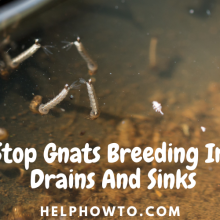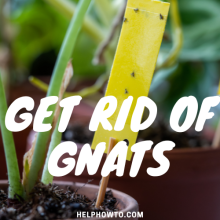Get Rid Of Moisture Sources To Prevent Gnats | HelpHowTo
Summary of Getting Rid Of Moisture Sources To Prevent Gnats
Gnats thrive in moist environments, making moisture control crucial for their elimination. Identifying and addressing sources of excess moisture, such as standing water, leaks, humid areas, and overwatered plants, is the first step. Fixing leaks, improving drainage, using dehumidifiers, and ensuring proper ventilation can help dry out damp areas.
Regularly inspecting for and promptly addressing moisture issues, both indoors and outdoors, is essential to prevent reinfestation. While eliminating moisture sources is an effective and eco-friendly approach, it can be time-consuming and may require costly repairs or renovations. Combining moisture control with other tactics like traps, natural predators, and targeted pesticides can provide long-term gnat prevention, but persistence and vigilance are key to maintaining a dry, gnat-free environment.

Our Top 5 Recommended Indoor Genat Traps
Sick of pesky gnats invading your home? Discover the top 5 indoor gnat traps to banish these annoying insects for good! Our expert reviews reveal the most effective, easy-to-use traps. From powerful UV attractants to eco-friendly vinegar traps, we’ve thoroughly tested and ranked the best solutions. Check Now

How To Prevent Gnats By Removing Moisture Sources
Gnats, those pesky little flies that seem to appear out of nowhere, can quickly turn a peaceful indoor or outdoor space into an annoying, buzzing nightmare. While they may seem like a minor nuisance, these tiny pests can be a significant source of frustration and even potential health concerns if left unchecked. The key to getting rid of gnats lies in addressing their primary habitat requirement: moisture.
Identifying Moisture Sources
Before you can effectively eliminate gnats, you must first identify the sources of moisture that are attracting them to your home or property. These can range from obvious culprits like standing water in sinks, bathtubs, and plant pots to more subtle issues like leaks from plumbing, appliances, and pipes. Humid areas such as basements, crawl spaces, and bathrooms can also harbor moisture that supports gnat populations. Even something as innocent as overwatered houseplants with saturated soil can become a thriving gnat habitat.
Other telltale signs of moisture issues that attract gnats include condensation buildup on windows and walls, damp basements or crawl spaces with poor ventilation, and wet organic matter like compost piles and mulch beds. Essentially, any area with excess moisture can become a prime real estate for gnats to lay their eggs and establish breeding grounds.
Eliminating Moisture Sources
Once you’ve identified the moisture sources, it’s time to take action. Fixing leaky plumbing, appliances, cracks, and gaps is a crucial first step in cutting off the water sources that gnats need to survive. Improving drainage, using dehumidifiers and fans, and ensuring proper insulation and vapor barriers can help dry out damp areas that gnats find attractive.
Emptying standing water, cleaning drains, and addressing any flooding or water damage is also essential for removing potential gnat breeding grounds. When it comes to houseplants, avoiding overwatering, using well-draining soil, and allowing the soil to dry between waterings can deny gnats a habitat to thrive.
Outdoors, clearing clogged gutters, regrading to improve drainage, and removing any standing water from birdbaths, pet bowls, or other sources can help prevent outdoor moisture issues that attract gnats.
Moisture Control and Prevention
Even after addressing existing moisture sources, ongoing moisture control and prevention measures are necessary to keep gnats at bay. Monitoring humidity levels and maintaining proper ventilation, especially in humid areas, can inhibit moisture buildup that gnats thrive on.
Regular inspections for moisture issues, both indoors and outdoors, can help identify potential problems before they become major gnat breeding grounds. Promptly addressing any damp areas or moisture buildup is crucial, as these can quickly become entrenched gnat infestations if left unchecked.
Additionally, checking houseplants, under sinks, and outdoor spaces for moisture buildup can help prevent new gnat infestations from taking hold. While moisture control is the foundation of gnat prevention, incorporating other tactics like gnat traps, introducing natural predators like nematodes, and judicious use of targeted pesticides can provide an extra layer of protection.
Downsides and Considerations
While eliminating moisture sources is an effective and environmentally friendly approach to gnat control, it’s important to recognize that it can be a time-consuming and ongoing process. Depending on the extent of moisture issues in your home or property, addressing the root causes may require significant effort and potentially costly repairs or renovations.
Additionally, some moisture control measures, such as the use of dehumidifiers or fans, may increase energy consumption and utility costs. Pesticide use, even targeted applications, should be carefully considered and always follow product instructions to avoid potential health risks or environmental impacts.
Conclusion
Gnats are more than just a nuisance; they can be a persistent and frustrating problem if left unchecked. By identifying and eliminating moisture sources, you can deprive these pests of the damp conditions they need to thrive and effectively control gnat infestations. While it may require ongoing vigilance and effort, implementing a comprehensive moisture control strategy combined with other prevention tactics can help create a dry, gnat-free environment for years to come.
Remember, persistence and attention to detail are key when it comes to moisture control and gnat prevention. Any overlooked areas of excessive dampness can quickly become reinvaded, undoing your hard work. By staying proactive and addressing moisture issues promptly, you can keep your home or property free from these annoying pests and enjoy a gnat-free living space.

Our Top 5 Recommended Indoor Genat Traps
Sick of pesky gnats invading your home? Discover the top 5 indoor gnat traps to banish these annoying insects for good! Our expert reviews reveal the most effective, easy-to-use traps. From powerful UV attractants to eco-friendly vinegar traps, we’ve thoroughly tested and ranked the best solutions. Check Now
FAQs and Answers
How do I identify and fix hidden moisture sources like leaks behind walls or under floors?
Here are some tips for identifying and fixing hidden moisture sources like leaks behind walls or under floors:
Identifying Hidden Leaks:
- Use a moisture meter to check for elevated moisture levels in walls, floors, and ceilings. High readings can indicate a concealed leak.
- Look for signs of water damage like discoloration, peeling paint/wallpaper, warping, or musty odors.
- Conduct a water auditing by monitoring your water meter when no water is being used. If it’s still running, there’s likely a hidden leak.
- Infrared cameras can sometimes detect temperature differences that may reveal hidden moisture.
- Professionals can use specialized leak detection equipment like acoustic sensors or tracer gas to pinpoint exact leak locations.
Fixing Hidden Leaks:
- Once the leak is located, you may need to remove sections of drywall, flooring, etc. to access the pipes/plumbing.
- Hire a licensed plumber to properly repair or replace any leaking pipes behind walls/floors.
- Fix any cracks, gaps, or entry points where water may have seeped in from the leak.
- Dry out affected areas thoroughly using fans, dehumidifiers, and moisture removal equipment.
- Replace any water-damaged building materials like drywall, insulation, subflooring, etc.
- Consider upgrading old plumbing if leaks are recurrent in the same area.
- For slab leaks under concrete floors, rerouting pipes or slab jackets may be needed.
Identifying and repairing hidden moisture sources takes diligence, specialized tools, and often professional expertise to fully resolve. Catching leaks early minimizes potential structural damage and prevents ideal conditions for gnat/pest infestations.
What are some effective ways to reduce humidity in large, open living spaces?
Reducing humidity levels in large, open living spaces can be challenging, but here are some effective ways to tackle the issue:
- Use dehumidifiers: Invest in one or more high-capacity dehumidifiers designed for large spaces. Place them strategically in areas where moisture tends to accumulate, and make sure to empty the collection tanks regularly.
- Improve ventilation: Increase air circulation by using exhaust fans, ceiling fans, or even opening windows when weather permits. This helps prevent moisture from becoming stagnant and encourages drier air to circulate throughout the space.
- Install a whole-house dehumidifier: For severe humidity issues, consider installing a whole-house dehumidifier integrated with your HVAC system. These powerful units can effectively control humidity levels throughout your entire home.
- Seal and insulate: Properly seal and insulate the living space to prevent moisture from seeping in from outside or other areas of the home. Caulk around windows, doors, and any cracks or gaps in the walls and floors.
- Use houseplants judiciously: While houseplants can help purify the air, be mindful of their watering needs and avoid overwatering, as excess moisture can contribute to humidity problems.
- Limit indoor humidity sources: Minimize activities that generate significant moisture, such as cooking, showering, or running humidifiers. Ensure proper ventilation in bathrooms and kitchens to remove excess humidity.
- Upgrade to energy-efficient windows: Consider replacing old, drafty windows with new, energy-efficient models that are better at preventing moisture intrusion and condensation buildup.
- Consider a vapor barrier: In some cases, installing a vapor barrier (a moisture-resistant material) under flooring or behind walls can help prevent moisture migration into the living space.
Monitoring humidity levels with a hygrometer and maintaining levels between 30-50% can help create a comfortable, moisture-controlled environment in large, open spaces while also deterring potential issues like mold growth, musty odors, and pest infestations.
How can I prevent moisture buildup in crawl spaces or other enclosed, poorly ventilated areas?
Preventing moisture buildup in crawl spaces and other enclosed, poorly ventilated areas is crucial to avoid mold growth, structural damage, and creating ideal conditions for pests like gnats. Here are some effective strategies:
- Improve ventilation:
- Install vents or fans to promote air circulation and allow moist air to escape.
- Consider adding a vapour barrier (plastic sheeting) on the ground to prevent moisture from seeping up.
- Use a dehumidifier:
- Place a dehumidifier in the crawl space or enclosed area to remove excess moisture from the air.
- Ensure proper drainage for the collected water.
- Seal and insulate:
- Seal any cracks, gaps, or openings that may allow outside moisture to enter.
- Insulate walls, floors, and ceilings to prevent condensation buildup.
- Address water sources:
- Fix any plumbing leaks or moisture intrusion from outside sources.
- Ensure proper drainage around the foundation to divert water away from the crawl space.
- Encapsulate the crawl space:
- Consider encapsulating the entire crawl space with a heavy-duty vapour barrier to isolate it from outside moisture.
- This may require professional installation but can be highly effective.
- Use a crawl space vent fan:
- Install a vent fan specifically designed for crawl spaces to continuously expel moist air and draw in drier air.
- Monitor and maintain:
- Regularly inspect the area for signs of moisture buildup or water damage.
- Promptly address any issues to prevent further moisture accumulation.
Combining these methods can help create a drier, well-ventilated environment in crawl spaces and other enclosed areas, reducing the risk of moisture-related problems and discouraging pests like gnats from taking up residence.
Are there any natural or DIY methods for reducing moisture and deterring gnats?
Yes, there are several natural and DIY methods you can try for reducing moisture and deterring gnats around your home:
- Baking soda: Sprinkle some baking soda in areas prone to moisture buildup. Baking soda is a natural desiccant that can help absorb excess moisture from the air and surfaces.
- Rock salt: Similar to baking soda, rock salt can be placed in moisture-prone areas to absorb dampness. Just be careful not to use too much around plants.
- Silica gel packs: Reuse those little silica gel packs that come with many products. Place them in damp areas to help absorb moisture from the air.
- Charcoal briquettes: Charcoal is highly absorbent and can help remove moisture when placed in enclosed spaces like crawl spaces or basements.
- Kitty litter: The clay in kitty litter is excellent at absorbing moisture. Place some in a shallow tray in damp areas.
- Houseplants: Plants like tillandsia (air plants), English ivy, and peace lilies can help remove moisture from the air through transpiration.
- Essential oils: Some essential oils like peppermint, lemongrass, and eucalyptus may help deter gnats naturally when diluted with water and sprayed around affected areas.
- Vinegar traps: Mix equal parts vinegar, water, and a few drops of dish soap in a bowl. Gnats are attracted to the vinegar but get trapped by the soap solution.
- Caulking and sealing: Use caulk to seal cracks and gaps that may allow moisture to seep in from outside.
- Improve ventilation: Use fans, open windows when possible, and ensure proper venting in bathrooms and kitchens to circulate air and reduce humidity.
While these natural methods can be helpful, severe moisture issues may still require professional assistance or the use of dehumidifiers and other equipment for complete resolution.
How do I know if I have a gnat infestation or if it’s a different type of fly?
Distinguishing between gnats and other types of small flies is important for implementing the proper control methods. Here are some tips to help identify if you’re dealing with a gnat infestation or a different kind of fly:
Appearance:
- Gnats are very small, typically 1/8 inch or less in size.
- They are thin-bodied with long legs and antennae.
- Fungus gnats are dark black or gray, while others may appear tan or translucent.
- Fruit flies are tan or reddish-brown and tend to hover around ripe fruits and vegetables.
- Drain flies are small, fuzzy, and tend to congregate around sinks and drains.
Behavior:
- Gnats often fly in erratic, zigzag patterns and swarm together.
- They are attracted to moisture sources like damp soil, leaks, and standing water.
- Fungus gnats tend to be found around potted plants or areas with decomposing organic matter.
- Fruit flies are drawn to overripe or fermenting fruits and vegetables.
- Drain flies hover near drains, sinks, and sewage areas with stagnant water.
Breeding Grounds:
- Gnats lay eggs in moist environments like damp soil, leaks, or standing water.
- Fungus gnat larvae thrive in the soil of overwatered houseplants.
- Fruit flies breed in rotting fruits, vegetables, and other organic material.
- Drain flies reproduce in the slime and debris buildup in drains and sewers.
If the tiny flies seem to swarm around potted plants, damp areas, or moisture sources, it’s likely a gnat infestation. If they congregate around drains or are drawn to ripe produce, it may be drain flies or fruit flies instead. Proper identification helps ensure you target the specific pest and its breeding source effectively.

Our Top 5 Recommended Indoor Genat Traps
Sick of pesky gnats invading your home? Discover the top 5 indoor gnat traps to banish these annoying insects for good! Our expert reviews reveal the most effective, easy-to-use traps. From powerful UV attractants to eco-friendly vinegar traps, we’ve thoroughly tested and ranked the best solutions. Check Now




